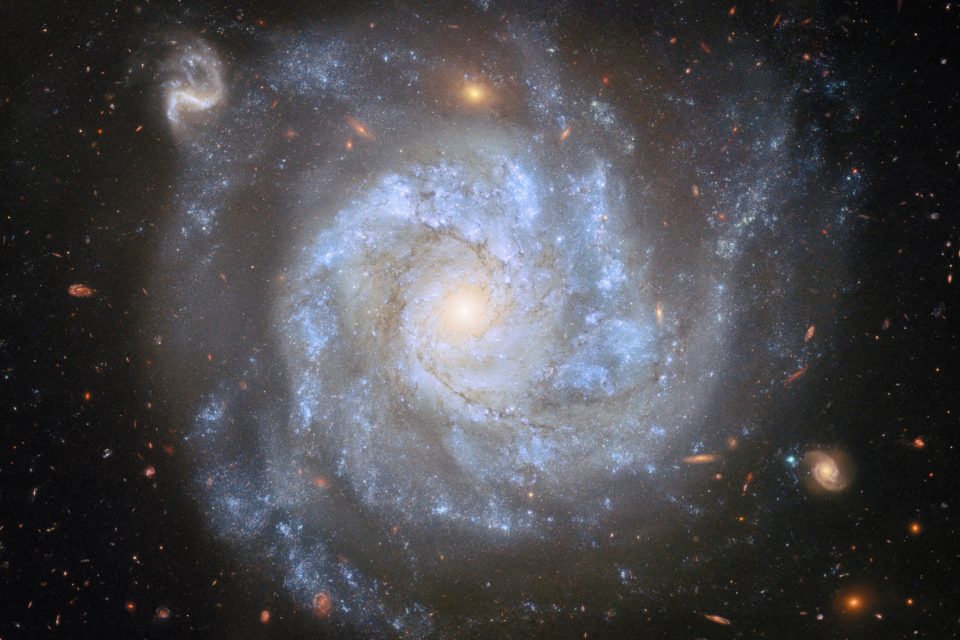Hubble reveals the strange afterlife of a zombie star
Today’s Image of the Day from the European Space Agency features the spiral galaxy NGC 1309. This graceful swirl of stars, gas, and dust is located about 100 million light-years away in the constellation Eridanus.
The new view captures the galaxy in exquisite detail. Its blue arms are full of young stars. The galaxy’s glowing white core is surrounded by hundreds of distant galaxies scattered across space.
Among the countless lights in the image, only one star belongs to our own Milky Way. It sits near the top of the frame, easily spotted by the characteristic diffraction spikes created by the Hubble Space Telescope’s optics.
Everything else – every tiny streak – is another galaxy, each home to billions of stars. It’s a humbling reminder of how crowded and immense the universe truly is.
A history of stellar explosions
NGC 1309 has long fascinated astronomers, not just for its beauty but for its dramatic history.
Over the years, the Hubble Space Telescope has revisited this galaxy multiple times, releasing images in 2006, 2014, and now again.
Each visit has revealed new insights about the stars living – and dying – within it. The galaxy is home to two remarkable supernovae: SN 2002fk and SN 2012Z. The first, SN 2002fk, was a textbook example of a Type Ia supernova.
These events occur when a white dwarf – the dense, burnt-out core of a dead star – accumulates too much matter from a companion star until it reaches a critical point and explodes.
Type Ia supernovae shine with such consistent brightness that astronomers use them as “standard candles” to measure vast cosmic distances, helping determine how fast the universe is expanding.
When a star refuses to die
A decade after SN 2002fk, NGC 1309 produced another surprise. In 2012, astronomers observed a second explosion, SN 2012Z, but this one broke the rules.
While it looked similar to a Type Ia supernova in its early stages, its light was dimmer than expected. It didn’t fit the classic pattern, and scientists soon realized they were looking at a different type of event – a Type Iax supernova.
This peculiar category represents a kind of failed explosion. Instead of completely tearing the white dwarf apart, the blast only partially disrupted it, leaving behind a remnant.
When Hubble revisited NGC 1309 years later, astronomers were stunned to find that the surviving star – nicknamed a “zombie star” – was still glowing, and even brighter than before the explosion.
The observations made this the first time the white dwarf progenitor of a supernova had ever been identified in pre-explosion images.
A zombie star’s strange afterlife
The discovery of the lingering remnant opened a new chapter in supernova research. It challenged the assumption that such explosions always spell the end for their parent stars.
Instead, the finding suggested that under certain conditions, white dwarfs can survive and continue shining – altered but not destroyed.
Astronomers are still studying how these partial explosions unfold and what triggers them. One idea is that the white dwarf doesn’t reach the critical mass needed for a full detonation, so the blast fizzles out halfway.
Another possibility is that the companion star siphons material in an uneven way, creating instability that prevents the star from fully disintegrating.
Whatever the mechanism, the result is an eerie hybrid – a stellar corpse that somehow clings to life.
Hubble continues to teach us
The Hubble Space Telescope, launched in 1990, has become one of humanity’s most trusted eyes on the cosmos.
The telescope’s sharp vision from Earth’s orbit allows astronomers to track changes across years and even decades – something ground-based telescopes struggle to do.
By repeatedly observing galaxies like NGC 1309, Hubble helps scientists connect the dots between stellar birth, death, and rebirth.
Supernovae such as SN 2002fk and SN 2012Z also serve a bigger purpose in astronomy. They act as natural laboratories for studying how elements are created and spread throughout galaxies.
Each explosion releases carbon, oxygen, and heavier metals that eventually become part of new stars, planets, and even life itself. The faint glow of a distant galaxy carries within it the record of countless cycles of creation and destruction.
A window into the past and future
NGC 1309 may look peaceful in Hubble’s portrait, but beneath its quiet spiral arms, the story of stellar evolution continues to unfold.
Massive stars burn out quickly, white dwarfs hover on the edge of collapse, and supernova remnants drift through space, enriching it with the ingredients for future worlds.
Every new image adds another layer to that story – one that connects cosmic violence to the gentle glow we see across the night sky.
As telescopes like Hubble and its successor, the James Webb Space Telescope, keep pushing the boundaries of what we can observe, galaxies like NGC 1309 remind us that even after a star’s apparent death, the universe still finds ways to surprise us.
Somewhere, out there among the spirals of Eridanus, a zombie star keeps shining – a small but spectacular testament to resilience written in the language of light.
Image Credit: ESA/Hubble & NASA, L. Galbany, S. Jha, K. Noll, A. Riess
—–
Like what you read? Subscribe to our newsletter for engaging articles, exclusive content, and the latest updates.
Check us out on EarthSnap, a free app brought to you by Eric Ralls and Earth.com.
—–




















